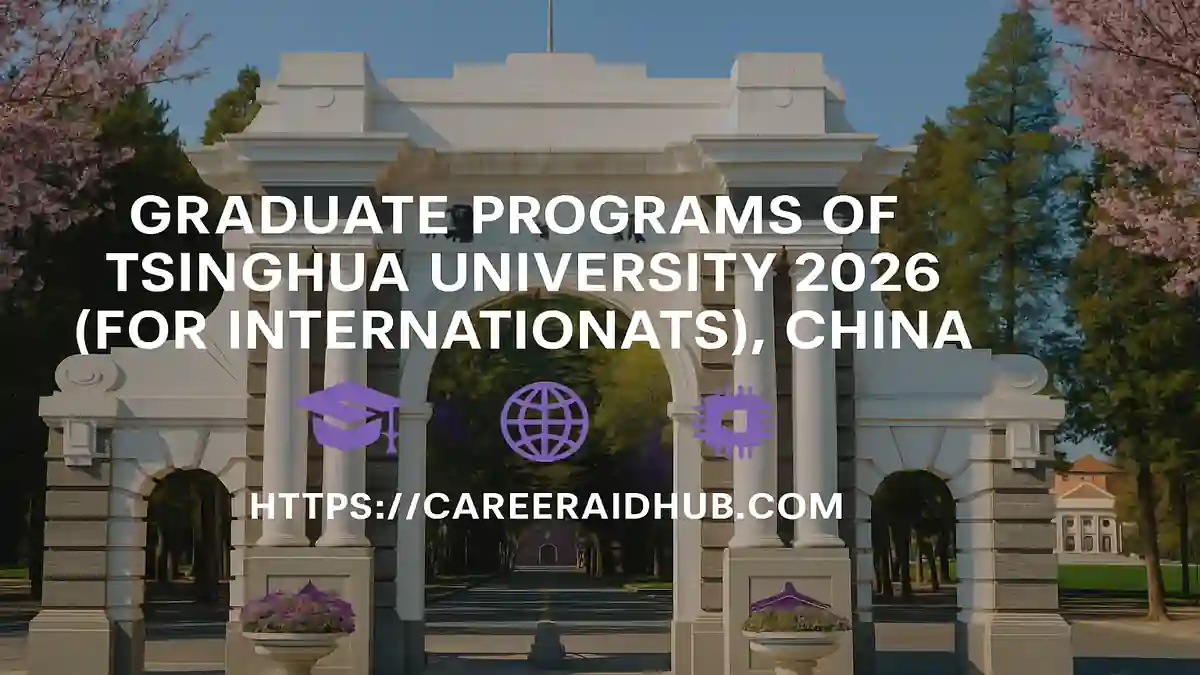University-Recommended Japanese Government (MEXT) Scholarship — University of Tokyo
The University of Tokyo (UTokyo) participates in the University-Recommended route of the Japanese Government (MEXT) Scholarship. In this track, Japanese universities conduct their own screening and then recommend finalists to MEXT for funding consideration. For the 2026 intake, UTokyo’s Graduate School of Science confirms this pathway and directs applicants to follow each graduate school’s procedures and timelines.
Considering a research-intensive master’s or doctoral degree in Japan? The University-Recommended MEXT Scholarship at the University of Tokyo offers a tuition waiver, monthly stipend, and airfare—together with a structured gateway into world-class laboratories. Start early, secure a faculty mentor, and submit a complete application through your intended graduate school.
What “University Recommendation” means—and why it matters
Unlike the Embassy Recommendation path, the University Recommendation route begins within UTokyo. Departments run a preliminary selection that evaluates academic performance, the quality and feasibility of the research plan, and the strength of alignment with a supervising professor. Candidates who rank highly in this internal review are forwarded to MEXT for the final decision.
Because nomination slots are limited, the process strongly favors applicants who have already
Bottom line: initiate contact with prospective supervisors well before deadlines, revise your proposal based on faculty feedback, and follow the precise documentation and timing requirements of the graduate school you intend to enter.
Funding snapshot
While final terms are always governed by MEXT’s annual guidelines, UTokyo’s scholarship information outlines the typical elements of support:
-
-
Tuition waiver: tuition and standard fees are covered under MEXT rules.
-
Monthly stipend: benchmark amounts for graduate students have commonly been around the mid-140,000 JPY level, with variation by student status (Master’s, PhD, or Research Student).
-
Airfare: economy-class travel to Japan at program start and return airfare at completion, subject to the scholarship’s travel provisions.
-
Duration: usually aligned to the normal period of your degree program (or a research-student phase), with potential extensions when advancing from research-student status to a degree—contingent on performance and re-screening.
-
Because stipend levels and durations can change, confirm the current figures when your graduate school opens
Who is a strong candidate?
A competitive University-Recommended applicant typically demonstrates:
-
-
Academic excellence: a strong GPA, rigorous coursework, and evidence of research potential—such as a thesis, publications, conference posters, or curated code/data.
-
Supervisor alignment: a clear expression of interest or invitation from a UTokyo professor or lab, plus a mutually agreed research theme that is feasible with available instruments, datasets, or field access.
-
Research plan quality: a structured plan with defined aims, method selection and justification, milestones, ethics/data-management considerations, and anticipated outputs (papers, datasets, or software).
-
Language readiness: the ability to conduct research in English or Japanese as required by the program; standardized test scores if the graduate school specifies them.
-
Professional conduct: timely communication, exacting documentation, and responsiveness to administrative requests.
-
Together, these elements help reviewers judge whether your project will progress on schedule, integrate with lab priorities, and contribute meaningfully to the University’s research environment.
Step-by-step: how to prepare a competitive dossier
1) Map your target graduate school and lab
Begin with your core discipline—for example, physics, biological sciences, mathematical sciences, earth and planetary science, or information science. Identify faculty whose recent publications and projects demonstrably overlap your area, then prioritize those actively recruiting. Prepare a
2) Confirm eligibility and timelines
Eligibility can differ by graduate school and degree level. Typical criteria include: nationality (with diplomatic relations with Japan), academic background, health requirements, age limits set by MEXT, and the ability to arrive on the program’s schedule. Because deadlines are school-specific, build a calendar that captures internal departmental milestones as well as scholarship documentation windows that may precede MEXT’s final stages.
3) Write a focused research plan (2–4 pages)
Prioritize clarity and feasibility. An effective structure is: Problem → State of the Art → Specific Aims → Methods & Feasibility → Timeline → Outputs & Impact → Risks & Mitigations. Specify data sources and access arrangements, software or compute requirements, anticipated ethics or safety approvals, and collaboration touchpoints within UTokyo. Where relevant, indicate how you will ensure reproducibility (e.g., version-controlled code and data documentation).
4) Assemble supporting documents
Expect to submit academic transcripts, degree certificates (or expected graduation letters), language-proficiency proof where required, a concise CV, and letters of recommendation. Some graduate schools request at least one letter from a dean-level official at your current or recent institution. Follow the exact wording of your target school’s instructions
5) Contact the administrative office early
Most graduate schools list an admissions or international liaison contact. Clarify upload portals, naming conventions, and file size limits. If the unit requires original documents at matriculation, plan for certified copies and timely international shipping. A brief, well-framed inquiry now reduces preventable errors later.
6) Submit a complete application—no placeholders
Upload polished PDFs and verify file legibility on different devices. Ensure that your name, dates, and degree titles are consistent across all forms. Keep submission receipts and any confirmation numbers. If originals will be inspected at enrollment, organize them in advance with translations where necessary.
Selection criteria you can influence
-
-
Scientific merit and originality: go beyond general interest statements to articulate a specific, field-relevant contribution. Explain how your approach closes a recognized gap in the literature.
-
Feasibility in the host lab: demonstrate that the required facilities, data, or field sites are available at UTokyo or through established partnerships; include letters or emails of intent where appropriate.
-
Trajectory and impact: map outputs that reviewers can measure—for example, two manuscripts, an open-source software release, a curated dataset, or a methods workshop.
-
Contribution to UTokyo’s ecosystem: describe how you will enrich the environment—guest lectures, seminar organization, student mentoring, or collaboration with adjacent groups.
-
Pro tip: include a succinct Gantt chart that spans semesters or quarters, with checkpoints for literature synthesis, data collection, analysis, drafting, submission, and revisions. The visual timeline helps reviewers judge pacing and resource needs.
Embassy vs. University Recommendation (quick contrast)
-
-
Starting point: The Embassy route begins at a Japanese embassy or consulate, whereas the University route begins with UTokyo’s internal selection.
-
Control of timelines: Embassy schedules are national; University schedules are set by individual graduate schools and may vary by department.
-
Supervisor engagement: Faculty support benefits both; however, the University route essentially requires strong supervisor alignment from the outset.
-
Seats: University-recommended seats are limited and highly competitive; departments will nominate only dossiers that convincingly match faculty and facilities.
-
This comparison underscores a practical reality: you increase your odds when you secure clear supervisor interest and deliver a tight, well-scoped plan that the lab can host immediately.
Key dates and next-cycle planning
Many UTokyo graduate schools operate autumn application windows for admission in the following academic year. For 2026 entry, anticipate that applications and internal screening will occur during the latter half of the preceding calendar year, followed by MEXT confirmation after UTokyo completes its recommendation stage.
Looking ahead: Based on recent patterns, the next cycle is likely to open in autumn with outcomes extending into winter/spring—we will update soon once each graduate school posts its exact months. Always rely on the specific graduate school’s official page for the final schedule and any updates or corrigenda.
Practical tips that boost outcomes
-
-
Write for an interdisciplinary reader: minimize unexplained jargon, define key acronyms at first use, and connect methodologies to concrete deliverables.
-
Document readiness: keep your passport validity, transcripts, and language scores current; minor administrative lapses can delay an otherwise strong application.
-
Scope calibration: a focused project with two strong, publishable units is usually preferable to an overly ambitious plan that risks timeline slippage.
-
Reproducibility and openness: when permitted, commit to releasing code, protocols, or data documentation—reviewers value transparent research practices.
-
Positioning beyond the scholarship: show how your UTokyo period fits into doctoral milestones, postdoctoral plans, or an industry or policy pathway.
-
These strategies collectively signal that you can deliver results on schedule, integrate with lab culture, and contribute to UTokyo’s research reputation.
Feature summary (for quick reference)
| Feature | Details |
|---|---|
| Program Name | University-Recommended Japanese Government (MEXT) Scholarship |
| Host Country | Japan |
| Funded By | Ministry of Education, Culture, Sports, Science and Technology (MEXT), via UTokyo recommendation |
| Duration | Degree-appropriate period; research-student phases may precede degree enrollment |
| Study Mode | Full-time, on-campus research at UTokyo |
| Eligibility | International applicants meeting MEXT and UTokyo graduate-school requirements |
| Financial Support | Tuition waiver; monthly stipend (benchmarks historically around the mid-140,000 JPY range); airfare per MEXT rules |
| Fields of Study | Broad coverage across UTokyo graduate schools; match with a suitable host lab is essential |
| Deadline | From October 15 to October 31, 2025 |
| Official Website | MEXT Scholarship |
Conclusion
The 2026 University-Recommended MEXT Scholarship at UTokyo is tailored for applicants who can present a feasible, well-scoped research plan and demonstrate clear alignment with a supervising professor and laboratory. Begin by engaging faculty, refine your methodology and outputs, and adhere exactly to your graduate school’s application checklist. For a consolidated overview of MEXT scholarship categories at UTokyo—including the University Recommendation pathway—consult the University’s central guidance before you finalize your file.
Frequently Asked Questions
It is a MEXT-funded route where UTokyo screens applicants first, then recommends finalists to MEXT for tuition waiver, monthly stipend, and airfare support.
University Recommendation starts at UTokyo departments. Conversely, Embassy Recommendation begins at embassies/consulates. Supervisor alignment is crucial for the university route.
Eligible international applicants must satisfy MEXT and UTokyo graduate-school requirements, including academics, health, arrival timing, and any language standards specified by the program.
Yes. Moreover, you should secure interest from a UTokyo professor and align your research plan with the lab’s facilities, datasets, and schedule.
Typically, it covers tuition waiver, a monthly stipend, and economy airfare. However, amounts and conditions can change; therefore, verify details with the current graduate-school call.
Highly competitive. Therefore, you must present strong academics, a feasible research plan, supervisor fit, and clear outputs like publications, datasets, or software releases.
Commonly, transcripts, degree certificates, language proof (if needed), CV, and recommendation letters. Additionally, follow each graduate school’s exact format and submission instructions.
Many programs accept English-medium applications. Nevertheless, some require Japanese or specific test scores. Always confirm the language policy for your target graduate school.
It usually matches the degree period or research-student phase. Furthermore, extensions can occur when advancing to a degree, subject to performance and re-screening.










